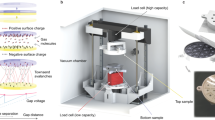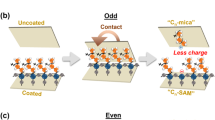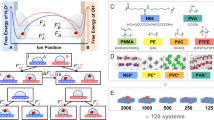Abstract
Charging of dielectrics on contact and separation has puzzled scientists and engineers for centuries. In a conventional view, the charges emerging on the two surfaces derive from the properties of the contacting materials, are of opposite polarities and are distributed approximately uniformly. However, a body of evidence has been mounting that contact electrification can also produce heterogeneous charge distributions in the form of (+/-) charge mosaics on each of the surfaces—yet, despite many attempts, no predictive model explaining the formation of mosaics at different length scales has been proposed; the main line of thinking has been that they must reflect some spatial heterogeneity present in the contacting materials. Here we describe experiments and theoretical models that prove a fundamentally different origin of mosaic formation: namely, not due to the properties of the contacting materials but due to electrostatic discharges between the separating surfaces. In particular, as the gap between the contact-charging surfaces grows, the threshold of the electric-field magnitude required for electrostatic discharge by Paschen’s law decreases, and eventually becomes lower than the electric field created in the gap by surface charges. Once a discharge starts, it continues not only until neutralizing but also locally inverting the surface charges. It is then the cycles of such discharges along the delamination front that give rise to the bipolar charge mosaics.
This is a preview of subscription content, access via your institution
Access options
Access Nature and 54 other Nature Portfolio journals
Get Nature+, our best-value online-access subscription
$29.99 / 30 days
cancel any time
Subscribe to this journal
Receive 12 print issues and online access
$209.00 per year
only $17.42 per issue
Buy this article
- Purchase on Springer Link
- Instant access to full article PDF
Prices may be subject to local taxes which are calculated during checkout






Similar content being viewed by others
Data availability
All the custom computer codes used in the present work (SKP control, experiment automation, data analysis and simulations) are available via Zenodo at https://doi.org/10.5281/zenodo.6650954. Experimental data and simulation results are available via the Harvard Dataverse repository at https://doi.org/10.7910/DVN/ZOFDKM.
References
Harper, W. R. Contact and Frictional Electrification (Laplacian Press, 1998).
Lacks, D. J. & Mohan Sankaran, R. Contact electrification of insulating materials. J. Phys. D: Appl. Phys. 44, 453001 (2011).
Pai, D. M. & Springett, B. E. Physics of electrophotography. Rev. Mod. Phys. 65, 163–211 (1993).
Bailey, A. G. The science and technology of electrostatic powder spraying, transport and coating. J. Electrostat. 45, 85–120 (1998).
Kwetkus, B. A. Particle triboelectrification and its use in the electrostatic separation process. Part. Sci. Technol. 16, 55–68 (1998).
Varis, J. Static dissipative compounds: solutions for static control. Plast. Addit. Compd. 3, 16–19 (2001).
Gibson, N. Static electricity—an industrial hazard under control? J. Electrostat. 40–41, 21–30 (1997).
Greason, W. D. Review of the effect of electrostatic discharge and protection techniques for electronic systems. IEEE Trans. Ind. Appl. IA-23, 205–216 (1987).
Davies, D. K. Harmful effects and damage to electronics by electrostatic discharges. J. Electrostat. 16, 329–342 (1985).
Felici, N. & Larigaldie, S. Experimental study of a static discharger for aircraft with special reference to helicopters. J. Electrostat. 9, 59–70 (1980).
Fang, Y., Chen, L., Sun, Y., Yong, W. P. & Soh, S. Anomalous charging behavior of inorganic materials. J. Phys. Chem. C 122, 11414–11421 (2018).
Lacks, D. J. The unpredictability of electrostatic charging. Angew. Chem. Int. Ed. 51, 6822–6823 (2012).
Lacks, D. J. & Shinbrot, T. Long-standing and unresolved issues in triboelectric charging. Nat. Rev. Chem. 3, 465–476 (2019).
Liu, C. & Bard, A. J. Electrostatic electrochemistry at insulators. Nat. Mater. 7, 505–509 (2008).
Xu, C. et al. On the electron-transfer mechanism in the contact-electrification effect. Adv. Mater. 30, 1706790 (2018).
Diaz, A. F., Wollmann, D. & Dreblow, D. Contact electrification: ion transfer to metals and polymers. Chem. Mater. 3, 997–999 (1991).
McCarty, L. S., Winkleman, A. & Whitesides, G. M. Ionic electrets: electrostatic charging of surfaces by transferring mobile ions upon contact. J. Am. Chem. Soc. 129, 4075–4088 (2007).
Salaneck, W. R., Paton, A. & Clark, D. T. Double mass transfer during polymer-polymer contacts. J. Appl. Phys. 47, 144–147 (1976).
Baytekin, H. T., Baytekin, B., Soh, S. & Grzybowski, B. A. Is water necessary for contact electrification? Angew. Chem. Int. Ed. 50, 6766–6770 (2011).
Henniker, J. Triboelectricity in polymers. Nature 196, 474 (1962).
Zou, H. et al. Quantifying the triboelectric series. Nat. Commun. 10, 1427 (2019).
Hull, H. H. A method for studying the distribution and sign of static charges on solid materials. J. Appl. Phys. 20, 1157–1159 (1949).
Bertein, H. Charges on insulators generated by breakdown of gas. J. Phys. D: Appl. Phys. 6, 1910–1916 (1973).
Shinbrot, T., Komatsu, T. S. & Zhao, Q. Spontaneous tribocharging of similar materials. Europhys. Lett. 83, 24004 (2008).
Knorr, N. Squeezing out hydrated protons: low-frictional-energy triboelectric insulator charging on a microscopic scale. AIP Adv. 1, 022119 (2011).
Burgo, T. A. L. et al. Triboelectricity: macroscopic charge patterns formed by self-arraying ions on polymer surfaces. Langmuir 28, 7407–7416 (2012).
Burgo, T. A. L., Silva, C. A., Balestrin, L. B. S. & Galembeck, F. Friction coefficient dependence on electrostatic tribocharging. Sci. Rep. 3, 2384 (2013).
Galembeck, F. et al. Friction, tribochemistry and triboelectricity: recent progress and perspectives. RSC Adv. 4, 64280–64298 (2014).
Barnes, A. M. & Dinsmore, A. D. Heterogeneity of surface potential in contact electrification under ambient conditions: a comparison of pre- and post-contact states. J. Electrostat. 81, 76–81 (2016).
Terris, B. D., Stern, J. E., Rugar, D. & Mamin, H. J. Contact electrification using force microscopy. Phys. Rev. Lett. 63, 2669–2672 (1989).
Albrecht, V. et al. Some aspects of the polymers’ electrostatic charging effects. J. Electrostat. 67, 7–11 (2009).
Burgo, T. A. L. & Erdemir, A. Bipolar tribocharging signal during friction force fluctuations at metal–insulator interfaces. Angew. Chem. 126, 12297–12301 (2014).
Baytekin, H. T. et al. The mosaic of surface charge in contact electrification. Science 333, 308–312 (2011).
Lowell, J. & Akande, A. R. Contact electrification—why is it variable? J. Phys. D: Appl. Phys. 21, 125–137 (1988).
Haeberle, J., Schella, A., Sperl, M., Schröter, M. & Born, P. Double origin of stochastic granular tribocharging. Soft Matter 14, 4987–4995 (2018).
Wang, A. E. et al. Dependence of triboelectric charging behavior on material microstructure. Phys. Rev. Mater. 1, 035605 (2017).
Baytekin, H. T., Baytekin, B., Incorvati, J. T. & Grzybowski, B. A. Material transfer and polarity reversal in contact charging. Angew. Chem. Int. Ed. 51, 4843–4847 (2012).
Sow, M. et al. Strain-induced reversal of charge transfer in contact electrification. Angew. Chem. Int. Ed. 51, 2695–2697 (2012).
Mizzi, C. A., Lin, A. Y. W. & Marks, L. D. Does flexoelectricity drive triboelectricity? Phys. Rev. Lett. 123, 116103 (2019).
Feshanjerdi, M. & Malekan, A. Contact electrification between randomly rough surfaces with identical materials. J. Appl. Phys. 125, 165302 (2019).
Chen, Y., Zhang, Y., He, L. & Zhang, S. L. Uniaxial strain-induced anisotropic charge transfer in contact electrification. Preprint at https://arxiv.org/abs/1912.05966 (2019).
Pandey, R. K., Kakehashi, H., Nakanishi, H. & Soh, S. Correlating material transfer and charge transfer in contact electrification. J. Phys. Chem. C 122, 16154–16160 (2018).
Grosjean, G., Wald, S., Sobarzo, J. C. & Waitukaitis, S. Quantitatively consistent scale-spanning model for same-material tribocharging. Phys. Rev. Mater. 4, 082602 (2020).
Xie, L., Bao, N., Jiang, Y. & Zhou, J. Effect of humidity on contact electrification due to collision between spherical particles. AIP Adv. 6, 035117 (2016).
Lee, V., James, N. M., Waitukaitis, S. R. & Jaeger, H. M. Collisional charging of individual submillimeter particles: using ultrasonic levitation to initiate and track charge transfer. Phys. Rev. Mater. 2, 35602 (2018).
Harris, I. A., Lim, M. X. & Jaeger, H. M. Temperature dependence of nylon and PTFE triboelectrification. Phys. Rev. Mater. 3, 085603 (2019).
Yu, H., Mu, L. & Xie, L. Numerical simulation of particle size effects on contact electrification in granular systems. J. Electrostat. 90, 113–122 (2017).
Shinbrot, T., Rutala, M. & Herrmann, H. Surface contact charging. Phys. Rev. E 96, 032912 (2017).
Apodaca, M. M., Wesson, P. J., Bishop, K. J. M., Ratner, M. A. & Grzybowski, B. A. Contact electrification between identical materials. Angew. Chem. Int. Ed. 49, 946–949 (2010).
Siek, M., Adamkiewicz, W., Sobolev, Y. I. & Grzybowski, B. A. The influence of distant substrates on the outcome of contact electrification. Angew. Chem. Int. Ed. 57, 15379–15383 (2018).
Derjaguin, B. V. & Krotova, I. A. Adhesion (in Russian) (USSR Academy of Sciences, 1949).
Derjaguin, B. V. & Smilga, V. P. Electronic theory of adhesion. J. Appl. Phys. 38, 4609–4616 (1967).
Derjaguin, B. V., Krotova, N. A., Karassev, V. V., Kirillova, Y. M. & Aleinikova, I. N. Electrical phenomena accompanying the formation of new surfaces, and their role in adhesion and cohesion. Prog. Surf. Sci. 45, 95–104 (1994).
Camara, C. G., Escobar, J. V., Hird, J. R. & Putterman, S. J. Correlation between nanosecond X-ray flashes and stick–slip friction in peeling tape. Nature 455, 1089–1092 (2008).
Brörmann, K., Burger, K., Jagota, A. & Bennewitz, R. Discharge during detachment of micro-structured pdms sheds light on the role of electrostatics in adhesion. J. Adhes. 88, 589–607 (2012).
Harvey, E. N. The luminescence of adhesive tape. Science 89, 460–461 (1939).
Bietsch, A. & Michel, B. Conformal contact and pattern stability of stamps used for soft lithography. J. Appl. Phys. 88, 4310–4318 (2000).
Moreira, K. S., Lermen, D., Campo, Y. A. S., Ferreira, L. O. & Burgo, T. A. L. Spontaneous mosaics of charge formed by liquid evaporation. Adv. Mater. Interfaces 7, 2000884 (2020).
Heinert, C., Sankaran, R. M. & Lacks, D. J. Microscale bipolar charge distributions on surfaces after liquid wetting and evaporation in an electric field. Langmuir 37, 8007–8013 (2021).
Budakian, R., Weninger, K., Miller, R. A. & Putterman, S. J. Picosecond discharges and stick–slip friction at a moving meniscus of mercury on glass. Nature 391, 266–268 (1998).
Ii, E. G., Barankin, M. D., Guschl, P. C. & Hicks, R. F. Surface activation of poly(methyl methacrylate) via remote atmospheric pressure plasma. Plasma Process. Polym. 7, 482–493 (2010).
Horn, R. G. & Smith, D. T. Contact electrification and adhesion between dissimilar materials. Science 256, 362–364 (1992).
Horn, R. G., Smith, D. T. & Grabbe, A. Contact electrification induced by monolayer modification of a surface and relation to acid–base interactions. Nature 366, 442–443 (1993).
Pence, S., Novotny, V. J. & Diaz, A. F. Effect of surface moisture on contact charge of polymers containing ions. Langmuir 10, 592–596 (1994).
Wiles, J. A., Fialkowski, M., Radowski, M. R., Whitesides, G. M. & Grzybowski, B. A. Effects of surface modification and moisture on the rates of charge transfer between metals and organic materials. J. Phys. Chem. B 108, 20296–20302 (2004).
Allen, K. R. & Phillips, K. Effect of humidity on the spark breakdown voltage. Nature 183, 174–175 (1959).
Kuffel, E. Influence of humidity on the breakdown voltage of sphere-gaps and uniform-field gaps. Proc. IEE Part A Power Eng. 108, 295–301 (1961).
Radmilović-Radjenović, M., Radjenović, B., Nikitović, Ž., Matejčik, Š. & Klas, M. The humidity effect on the breakdown voltage characteristics and the transport parameters of air. Nucl. Instrum. Methods Phys. Res. B Beam Interact. Mater. At. 279, 103–105 (2012).
Acknowledgements
We thank C. Cahoon for the X-ray photoelectron spectroscopy measurements; S. R. Waitukaitis for a critical peer review of the manuscript and multiple corrections to the polarity-inversion condition; E. Edel and S. Zyubin for providing full texts of rare, early twentieth-century articles. We thank the Institute for Basic Science, Korea, for generous funding under Project IBS-R020-D1.
Author information
Authors and Affiliations
Contributions
W.A., M.S. and Y.I.S. designed the experiments, built the experimental setups and analysed the data. W.A. performed the experiments and measurements with input from Y.I.S. Y.I.S. created the software for experiment automation, data analysis and simulations, and also developed theoretical models with input from W.A. and B.A.G. B.A.G. and Y.I.S. wrote the manuscript with input from W.A. and M.S. B.A.G. conceived and supervised the project.
Corresponding author
Ethics declarations
Competing interests
The authors declare no competing interests.
Peer review
Peer review information
Nature Physics thanks Bolong Huang, Thiago Burgo and the other, anonymous, reviewer(s) for their contribution to the peer review of this work.
Additional information
Publisher’s note Springer Nature remains neutral with regard to jurisdictional claims in published maps and institutional affiliations.
Supplementary information
Supplementary Information
Supplementary Sections 1–10, Figs. 1–34, captions to Supplementary Videos 1–3 and refs. 1–45.
Supplementary Video 1
a–c, Recording of ESD by a high-sensitivity camera: both raw video (b) and enhanced by post-processing (c) are shown in parallel with the coulomb-meter recording (a). Spikes of coulomb-meter current accompany ESD events. d, Charge density of the PMMA film measured by SKP after the experiment. This recording corresponds to Fig. 3.
Supplementary Video 2
Video recording and real-time data from a single experiment, with reconstruction of charge mosaics’ emergence.
Supplementary Video 3
Computational model of the ESD events occurring in the course of the detachment (peeling) process. This video corresponds to Fig. 6. Flow of time in this animation is not uniform: whenever an ESD occurs, detachment progress (indicated on top) is halted and multiple iterations of the computational model are performed until the ESD is extinguished. This simulation was performed using an initial charge density of 𝜎0 = 9 nC cm−2.
Rights and permissions
Springer Nature or its licensor holds exclusive rights to this article under a publishing agreement with the author(s) or other rightsholder(s); author self-archiving of the accepted manuscript version of this article is solely governed by the terms of such publishing agreement and applicable law.
About this article
Cite this article
Sobolev, Y.I., Adamkiewicz, W., Siek, M. et al. Charge mosaics on contact-electrified dielectrics result from polarity-inverting discharges. Nat. Phys. 18, 1347–1355 (2022). https://doi.org/10.1038/s41567-022-01714-9
Received:
Accepted:
Published:
Issue Date:
DOI: https://doi.org/10.1038/s41567-022-01714-9
This article is cited by
-
Static charge is an ionic molecular fragment
Nature Communications (2024)
-
Discharge domains regulation and dynamic processes of direct-current triboelectric nanogenerator
Nature Communications (2023)
-
Triboelectric charge saturation on single and multiple insulating particles in air and vacuum
Scientific Reports (2023)



